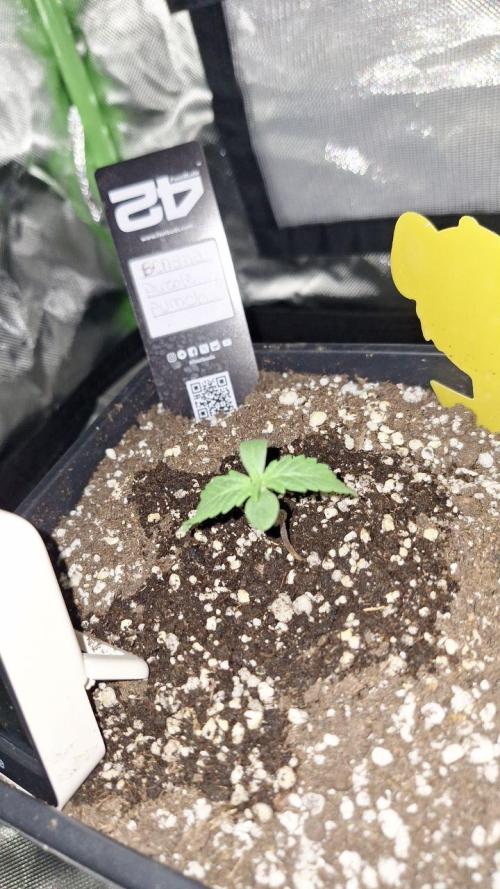By continuing to use the website or clicking Accept you consent to our cookies and personal data policy and confirm that you are at least 18 year old. For details please see Privacy Policy and Terms
Accept
Why is she still so tiny?
BunnyBudstarted grow question 2mo ago
Hey growers! 🌱 First auto, germed 16/08 (under LED since 17). Lightmix+perlite, LED was 60cm now 50, 16/8h (only 8h on day 1), 26-28°C, 60-70% RH. Watered 168→129 ppm w/ 1 drop Grow. After 1 week still stuck at first true leaves. Normal? Switch to 18/6–20/4? Light ok?
Solved
likes
00110001001001111Oanswered grow question 2mo ago
normal for 6 days
stick to 18/6 unless your light sucks. At this stage you might not need 'max' light. Allow resulting node spacing dictate light intensity. The only reason to go to 20/4 is if your light can't give enough DLI over 18h, and right now due to its age it may not be able to handle full power.
too much stretch? turn up light or get it closer. Too tight? Reduce light or get it farther away. Make sure new sets of leaves don't stay tight and make sure they don't stretch out too much and you ahve the correct amount of light.
You can use hours of operation, too, but usually a dimmer is a better option. With a tiny plany you can hang it closer and run fewer watts to save electricity. That takes trial and error. Take notes if you do that for % power, distance and age of plant. Adjust ramp up for next cycle based on what you learn. Much easier to give a suggestion for full coverage.
at full power it's better to just hang it at a proper height relative to the area of coverage. What is best for sides/corners without sacrificing overall average umol/s PAR readings (ppe/ppf). Your average ppf over entire canopy is a good estimate for PPFD. That is the value you can reference with hours of operation on a DLI table (daily light integral).
DLI is what matters. whether you give it over 12h or 18h or 20h really doesn't matter. Since a proper dark cycle is beneficial, avoid 20/4 and longer unless you have an under-powered light relative to area of coverage.
With ambient co2, 35-40DLI is all a plant can handle - auto or photo. Temp, RH and ambient co2 dictate "max" dli. it will vary baed on these factors. 35-40 is just a good starting point. as stated above... you adjust based on plant growth. that is what matters above all else.
---------------
SF1000D? The following is for a mature plant that can handle max dli relative to environmental factors...
Their spec shet is retarded. Can't have a 2.5umol/J efficacy and a 200umol/s output. That's a 2.0umol/J efficacy.
~210 diodes counting from picture.. Roughly 0.5watts per diode which is 2.5x more power than samsung.com tests them. so the ~200umol/s PAR is probably correct and the 2.5 efficacy is a lie. This is not enough diodes for high efficacy. Expect a shorter life than advertised - i.e. it will dim to "90%" faster than 50k hours.
High efficacy saves electricity and reduces heat production. As long as the plant gets teh proper DLI and the heat doesn't cause any problems, the plants will grow just as well as any other LED of same characteristics (CCT, R:B ratio etc). So, the light is fine and can perform well as long as you stay within it's limitations, which is true of all lights. This one will just dim faster and add a bit more heat. Sometimes that's good.. if you need an extra C or 2, it's a benefit in some respects.
over 18 hours you want ~600 PPFD. This PPFD over 18h is 38.9 DLI. (again, actualy max is relative to local variables... this is merely a good starting point). Google "DLI table" for easy reference.
about 1/3m^2 is all the area you want to cover (600ppfd * ,333m^2 = 200 "umol/s PAR" or "ppf").. that's roughly 3.6sq ft of very solid coverage. give or take a fraction is fine too... but to push upper 30s DLI, less than 4sq ft is best.
once it's mature.. i'd hang it for optimal coverage of just under 2' x 2'. 18 hour operation. A free light app can help. eyes are not sufficient. A qb is probably best around 18" for a starting point. Diode distribution impacts what is best, too.. if it's rectangular, the best coverage is also rectangular not square.
if you jumped to 20h with this light it could cover more area in a proportional way, all other factors the same. 1/9th more hours means 11.1% more DLI or raise it slightly to spread it out more and cover 11.1% more area than before while maintaining same DLI, give or take.
read wiki on DLI. Get the gist. Proportional to hours of operation, inversely proportional to area of covrage. PPFD is not a single-point reading. Once you have your ligth dialed in, this can make adapting to a slight change very easy.
e.g.
If you grow photoperiods (12h operation vs 18h), you need to cover 2/3rds of the above area or beef up the light 150% to maintain same area (well, what you learn to work best is the new starting point)... ~0.22m^2. or 2.4ft^2. all other factors the same is 2/3rds the area. rounding on conversion.
Terpy_Burpzanswered grow question 2mo ago
Perfectly Normal. There are a lot of growers on here that don't take the time to fill out the grow details and show 7-week-old plants they label as week 2 veg, etc It's very confusing, and this may be where you are getting confused. I rule is at this stage in life, a set of leaves a week is good, a set and a half is excellent, but they don't grow faster than that. Don't worry, in three weeks you will be really happy and will be starting to plan some LST. Definitely don't stray from 18 hours of light, 6 hours dark for Autos. It's looking good, don't panic, you are doing a great job!
1 like
Complain
Core_T_Sonanswered grow question 2mo ago
Anfangs wächst die Pflanze abwechselnd über der Erde und unter der Erde. Die sieht gesund aus, warte mal bis morgen und mach nochmals ein Foto. Das sollte dann definitiv anders aussehe
1 like
Complain
John_Krameranswered grow question 2mo ago
for this tiny i'd recommend 24h with 15k lux that 'd be 24 DLI
p.s. auto must've 24h bs it's F machine (imho)
1 like
Complain
Kushycatanswered grow question 2mo ago
To be honest, I don't see a problem there. A little patience sometimes works wonders. It's only been a few days. 😛
1 like
Complain







